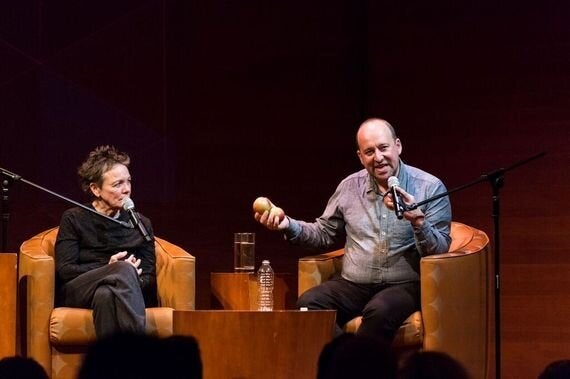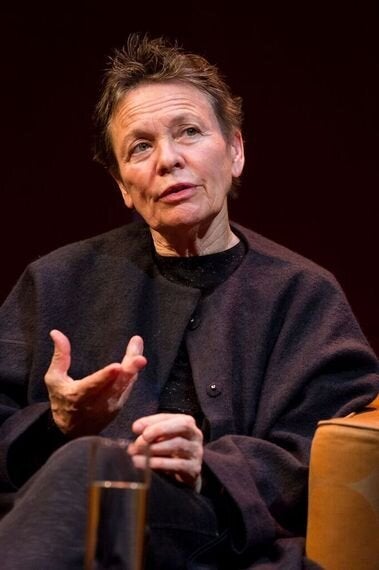On the heels of the Paris Climate talks, was a very important conversation held at The Rubin Museum in New York City. I was one of the lucky few who was there. One thing artist and film-maker Laurie Anderson shares with world renowned Climatologist Gavin Schmidt, is that they both have worked with NASA. Anderson also shares my well established suspicion and embedded dislike of TED Talks, as the speakers always have a book to sell or a product to push on their information greedy listeners. This was one of the many intriguing minutiae obtained about Ms. Anderson when I intended a recent sold-out discussion held in New York's beautiful Rubin Museum of Art. What they were talking about, however, is the Climate Crisis, which arrives at the finishing of the Paris Climate Talks.
Gavin Schmidt is an authoritative climate scientist who uses data to create a virtual reality model of earth, he also has found himself on a list of seventeen international "climate criminals" being passed around on the floor of the Senate. He looks at the past and present to predict the future. Anderson, on the other hand, is known primarily for her multimedia presentations, she has cast herself in roles as varied as visual artist, composer, poet, photographer, filmmaker, electronics whiz, vocalist, and instrumentalist. When I spoke to her after she was very patient and warm.

Laurie Anderson In Conversation With Gavin Schmidt at The Rubin Museum of Art
Copyright: Jacqueline Iannacone
The most frequent word used by Anderson in this compelling back-and-forth between these two visionaries, was the word "Collapse". Is the world on the verge of Collapse because of the increasing negligence of managing Climate Change?
"There is," delivered Anderson, "a motivation never to change anything, a nineteenth century idea." That people love the world as it is. To be awake to the world, and to see it. That is the job of the artist, she regaled us. Resistance to Climate Change is ultimately a resistance to difference. One thing she also mentioned, which was really disorientating, was the fact that time is working in a different way, simultaneously to that of our own. The time of the earth. Its evolution, degradation, upset, and unpredictability.
One thing about this potential gloomfest, however, according to Gavin Schmidt, is that big disasters can lead to solutions. Or inspire them, at least. What I began to attend mind to while listening to this engrossing exchange, is that our world is so much more astounding than one probably assumes it to be on any regular day. Take the last Ice Age for example. The Pleistocene Epoch, very basically defined as the time period that began about 1.8 million years ago and lasted until about 11,700 years ago. The most recent Ice Age had then occurred, as glaciers covered huge parts of the planet Earth. Five subsequent documented major ice ages have taken place during the 4.6 billion years since the Earth was formed.
One of the richest sources of information about life in the Pleistocene Epoch, should be curious enough to seek it out, can be found in the La Brea Tar Pits in Los Angeles, where remains of everything from insects to plant life to animals were preserved, including a partial skeleton of a female human and a nearly complete woolly mammoth. Whole worlds were destroyed and species wiped out. Potential for all sorts of evolutions, struggles, intelligent developments, and it scares and fascinates should one pay it enough ponder.

Laurie Anderson at The Rubin Museum of Art, New York City.
Copyright: Jacqueline Iannacone
Anderson pointed out at The Rubin, that the Arctic sea ice is continuing its frightening declination with the amount of winter ice cover falling to its fifth lowest on the satellite record, according scientists at the National Snow and Ice Data Center. Specifically, The decline of Arctic sea ice in summer is occurring at a rate that exceeds most model projections, the United Nations' intergovernmental panel on climate change said in releasing its first report since 2007. Russian scientist Dr Habibullo Abdussamatov, of the St Petersburg Pulkovo Astronomical Observatory, painted the Doomsday scenario saying the recent inclement weather simply proved we were heading towards a frozen planet. Another Ice Age? Collapse?
There is some hope, though, in taking on the Climate calamity. The cost of providing electricity from wind and solar power plants has plummeted over the last five years, so much so, that in some markets renewable generation is now cheaper than coal or natural gas. Schmidt highlighted this upcoming trend. Utility executives say the trend has accelerated this year, with several companies signing contracts, known as power purchase agreements, for solar or wind at prices below that of natural gas, especially in the Great Plains and Southwest, where wind and sunlight are abundant.
"The key environmental question facing us now (and for at least the next century)", Schmidt said in a recent interview, "is to what extent are the changes we are making to the atmosphere, to the oceans, to the composition of the air, going to impact sea levels, temperature, and rainfall and hydrological resources?" Moving forward, Schmidt said we are only floundering along by tackling Climate Change at about 10% of the rate we should be. In order to prevent the flooding, protect the polar ice caps, to change to new energy sources and solutions, we need to invoke an emotional transition in the hearts and minds of the majority, to invoke a narrative digestible to attract people toward dealing with preventing "Collapse". To provide interstate co-ordination in the States as well as more proactive diplomacy surrounding the issue. All of the obvious things that are being neglected. What we need, is leadership.
